The Ballantine Adult Fantasy Series: Lud-in-the-Mist by Hope Mirrlees
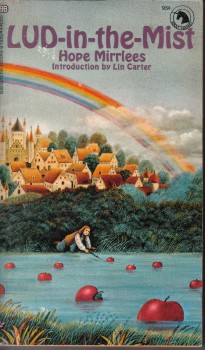 Lud-in-the-Mist
Lud-in-the-Mist
Hope Mirrlees
Ballantine Books (273 pages, March 1970, $0.95)
Cover art by Gervasio Gallardo
One of Lin Carter’s greatest achievements as editor of the Ballantine Adult Fantasy series, in my opinion, was rescuing Lud-in-the-Mist from obscurity. The third and final novel by Hope Mirrlees, Lud-in-the-Mist was her only fantasy. After this book was published, she stopped writing. More on that later.
Carter tells the story in his introduction that he had never heard of the book when a friend recommended it to him. The friend had a copy, which he loaned to Carter. Carter was immediately impressed and wanted to include Lud-in-the-Mist in the BAF series. At the time, Carter says, he didn’t know if Ms. Mirrlees was even still alive. (She died in 1978.) It’s questionable how much effort he put into locating her, since by that time the book was in the public domain.
The story takes place in a country based on both England and the Low Countries. Lud-in-the-Mist is the capital of the small country of Dorimare. It is situated at the confluence of two rivers, the Dapple and the Dawl. The Dawl is the largest river in Dorimare. The Dapple, on the other hand, has its source beyond the Debatable Hills in the land of Fairy.
Until 200 hundred years ago, relations between Dorimare and Fairy were good. Then, during the reign of Duke Aubrey, the merchants rose up and overthrew him. Aubrey wasn’t the best of people. He had a bet going with another man that they could drive the court jester to suicide. (They were successful.) But he wasn’t all bad, either. He was also known for acts of extreme generosity.
Since the time of the revolution, all traffic with the inhabitants of Fairy is forbidden. Indeed, even mentioning fairy fruit is illegal. According to the Law, it doesn’t exist, despite the fact that it was consumed with regularity before Duke Aubrey’s overthrow.
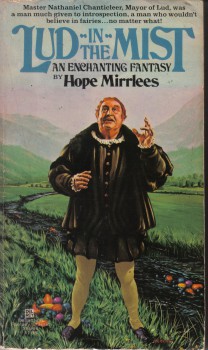
The novel concerns Master Nathaniel Chanticleer. He’s the Mayor. When he was a boy, he found an old harp in the attic. Upon plucking a string, he heard a Note that he’s never heard since.
Chanticleer isn’t your typical fantasy hero. He’s older, overweight, has marriage problems, and is something of a distant father to his son and daughter. He’s part of the upper classes, who are all vain, pompous, and somewhat foolish.
In fact, there are no typical heroes, and depending on how exactly you define “hero,” you could argue that there really aren’t any heroes in the book, even though some of the characters perform heroic acts. There are a couple of villains, but for the most part, even their motives are understandable.
Things get rolling when Nathaniel’s son Ranulph is given some fairy fruit by a hired hand, who then disappears before he even gets paid. The worried parents call in Dr. Endymion Leer. He’s got the largest practice in town, although it’s mostly confined to the lower classes of society. His treatment seems to be the only thing that helps Ranulph’s condition. He suggests that Ranulph spend some time in the country on a farm, and he has just the farm in mind, one owned by the Widow Gibberty.
But Leer has secrets and an agenda of his own…
Nathaniel thinks that everything is fine, but he soon learns otherwise. The daughters of the merchant class attend Miss Primrose Crabapple’s Academy for Young Ladies (and are called by everyone the Crabapple Blossoms). One day, a new dance instructor shows up and plays for them some wild tunes on the fiddle. In no time at all, the Crabapple Blossoms are hot-footing it for the Debatable Hills.
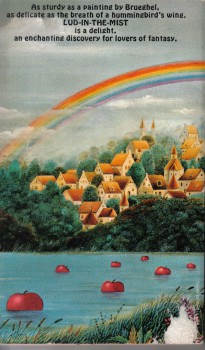
During the ensuing crisis, Endymion Leer manages…well, I’ll let you read the book yourself. I recommend this one highly.
Lud-in-the-Mist was written before fantasy had become a well-defined genre. As a result, the story doesn’t do some of the obvious things a modern reader would expect. As I mentioned, there are no heroes in the mold of today’s rugged warriors.
Instead we have a novel written from a literary perspective, with info dumps and background and detailed descriptions of the characters’ inner lives and family histories that you usually don’t see in pure genre writing. It’s a testament of Ms. Mirrlees’s skill that these passages are as engaging as the rest of the novel.
Much of Lud-in-the-Mist can be read as social satire, albeit gentle satire. Mirrlees seems to have a fondness for almost all her characters, in spite of the flaws with which she imbues them. The only real exception I can think of is the Widow Gibberty, who has no redeeming characteristics at all. Many of the characters do vile things from the best of motives. No one is presented as without flaws. But other than the Widow, they are all presented with sympathy.
The whole theme of the story concerns the need for the fantastic in the mundane. By forbidding contact with Fairy, the merchants of Lud-in-the-Mist have created a totally mundane society, what in contemporary terms would be called a secular society, as the priests all leave when Duke Aubrey is overthrown. The society in Dorimare is presented as one that is bleak and dull. The arts are not central to daily life, and other than music, there doesn’t appear to be much social support for anything involving creativity. I suspect it’s not a coincidence that the inhabitiants of Lud-in-the-Mist are called Luddites.
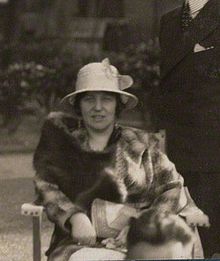
Ms. Mirrlees makes the argument that separating the fantastic from the mundane is harmful to society, that both are necessary. I suspect this is an argument most of you can support.
I mentioned earlier that Lud-in-the-Mist was the final novel Mirrlees wrote. After the death of her mentor and friend Jane Harrison, Mirrlees ceased writing. Both her father and grandfather were industrialists, so Mirrlees didn’t need to write for money.
It’s too bad she didn’t write more fantasy. Although well-received, her first two novels, which weren’t fantasy, are totally forgotten today. If Mirlees had continued to write fantasy, she could very easily have become one of the major authors in the field.
From what I’ve been able to determine, the BAF edition is the first edition of Lud-in-the-Mist published after two editions in the 1920s. Today multiple editions, both in print and electronic formats, are available.
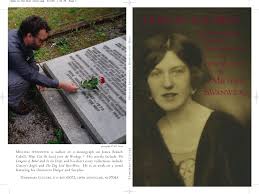
Michael Swanwick has written a biography of Hope Mirrlees which appears to be out of print, Hope-in-the-Mist: The Extraordinary Career and Mysterious Life of Hope Mirrlees. It’s one I’m going to keep an eye out for.
I’m not sure what I’m going to read next. After Lud-in-the-Mist are three titles by authors we’ve looked at before, namely Dunsany, MacDonald, and Lovecraft. I may skip to the first Clark Ashton Smith title, Zothique, or I may read something else entirely from later in the series. If anyone has any requests, let me know. No promises, but I’ll certainly take any suggestions under consideration.
Recent posts in this series are:
Lin Carter and the Ballantine Adult Fantasy Series
Lilith by George MacDonald
The Silver Stallion by James Branch Cabell
The Sorcerer’s Ship by Hannes Bok
Deryni Rising by Katherine Kurtz
Land of Unreason by Fletcher Pratt and L. Sprague de Camp
The Doom that Came to Sarnath by H. P. Lovecraft
The Spawn of Cthulhu edited by Lin Carter
Keith West blogs way more than any sane person should. His main blog is Adventures Fantastic, which focuses on fantasy and historic fiction.
This novel blew me away when I read it a few years ago – it’s such an advantage writing before your genre is well-defined! Mirrlees clearly wasn’t out to meet anyone’s expectations but her own.
Thomas, you’re completely correct. Many of the works written before fantasy became a distinct marketing niche have a very different flavor that anything being produced today, Lud-in-the-Mist being a prime example. That’s been one of the more rewarding aspects of writing this series of posts. One of the reasons I enjoyed Lud-in-the_mist and The King of Elfland’s Daughter so much is that while they were clearly fantasy, they didn’t follow contemporary genre tropes. Consequently, they had an element of unpredictablility about them that I found refreshing.
I’d hope that you’d work your way through the series in the order of the releases, so that we get more of a sense of how it developed than might happen otherwise.
Major, that was the general idea when I started. With a couple of exceptions (Deryni Rising because I really wanted to read it and the Lovecraft posts because of Halloween) I’ve mostly gone in order. There are three Cabell books in the first dozen titles, and I’ve only read the first one. Should I go back and catch up on those? I really would like to know what you and other readers think.
Also, I skipped the first two anthologies in the series, Dragons, Heroes, and Elves and The Young Magicians. I should probably go back and take a look at those.
Great post — this is still one that I haven’t read.
Don’t skip those anthologies — there are some fine, fine stories in there! One of them has what is probably the best story Lin Carter ever wrote, “Zingazar,” perhaps his only short story that can stand shoulder to shoulder with some of the greats, although the short Thongor stories (not the novels) are a lot of fun.
My preference? Skip Cabell entirely — a parodist, not a serious contributor to high fantasy or even swords-and-sorcery. If one’s going to include him, why not something like Bored of the Rings? I admit my dislike of his work is largely based on old impressions of reading Jurgen and reading about him here and there. Perhaps someone will want to argue that Cabell has more in common with, say, Tolkien and Eddison than with the writers for Harvard Lampoon.
I’d like to see you turn to the two early anthologies and mostly proceed in order thereafter through the series. If I were doing the tour, I’d likely omit the Cthulhu Mythos stuff. That always seemed like it was there because Carter liked it and not because it belonged in a series with Morris, Dunsany, MacDonald, et al. (Lovecraft’s Dunsanian efforts would be another matter: I’d have time for The Dream-Quest, “The Quest of Iranon,” etc.)
I’d also skip Machen’s Three Impostors.
I wouldn’t be able to resist writing about Chesterton’s Man Who Was Thursday — one of my favorite books of a 50-year reading life — though I’m not sure it belonged in the series.
Any time one omits anything issued inthe series, of course, one could be criticized for discussing one’s own idea of a fantasy series for adults, rather than what was actually issued.
The Young Magicians is an interesting one for me — got me going on a number of authors, some of whom I outgrew (basically the swords-and-sorcery ones) and some of whom remained of interest.
I’d also throw in a vote for one of the anthologies. Or maybe Shaving of Shagpat — I’d like to see someone else’s opinion on it.
As for Cabell, I’d say whether he warrants revisiting or not is entirely down to how you felt about the first book. Myself, I enjoyed all of them, but they’re all fairly similar in tone.
Since you started these posts I’ve gone from owning a few of these old Ballantine editions to owning almost all of them (I have only about 5 or 6 to go). They are absolute treasures. I’m so glad that I learned about these books.
I just finished Cabell’s The Silver Stallion, which I did not really care for. I’m currently reading his Figures of Earth, which so far is much, much better–more like fantasy than satire. I definitely think you should cover them, at least one of them. It might be interesting to discuss why Carter continually went back to certain authors.
Also, it’s interesting the comment from Wooton about Lovecraft not really fitting in this series. Maybe so; but I don’t think this is only Carter’s idiosyncrasy. Given that the first World Fantasy convention was in the early 70s and that Lovecraft was honored at the very first one, not to mention that his bust is on the world fantasy award, I hardly think that Lovecraft was just a peculiar taste of Carter at the time.
Moreover, I’ve always thought of Lovecraft in the fantasy vein given that my first exposure to him was in the original Deities and Demigods book for the Dungeons and Dragons RPG back in the early 80s. It seems that Gary Gygax also saw Lovecraft as definitely in the fantasy realm.
Love these posts! Keep ’em up!
Thank you, everyone, for your input. I do appreciate it.
Howard, you really should read this one. It’s one of the best I’ve read so far.
Major, The Man Who Was Thursday is definitely one I intend to read.
Joe H., likewise for The Shaving of Shagpat. I just haven’t gotten there yet.
James, thank you. I’m glad you’re enjoying the posts.
General remarks: I’ll definitely be reading the anthologies. I skipped them because Dragons, Elves, and Heroes looked like it was going to be more work than I was up for at the time. I’ll try to get started on it before the spring semester begins.
When I started this series of posts, I said I would read at least one book by every author represented, but I didn’t promise more than that. Cabell is borderline. Major raises some good points about skipping titles. On the other hand, I’m doing this for fun, and slogging through a book I don’t enjoy ain’t fun.
I’m willing to give Figures of the Earth a try. After that, we’ll see. I’m definitely going to read Lovecraft’s Dunsanian fantasies, so The Dream-Quest of Unknown Kadath is on the list.
And speaking of Dunsany, Howard Andrew Jones is reading through some of Dunsany’s collections over on his blog. (I’ve gotten behind, which is why I haven’t commented there in the last few weeks. I promise I’ll get caught up, Howard.) I’ve toyed with the idea of skipping the Dunsany collections and pointing people to Howard’s site, but I think that would be a bad idea. Carter compiled them the way he did for a reason, so looking at them will give an understanding of what Carter wanted to accomplish with the BAF series.
Finally, one last question: How do you feel about my including some of the titles Ballantine printed before launching the BAF series? I’m thinking Eddison, Peake, and Beagle here, not Tolkien.
I think Eddison, Peake, and Beagle would definitely have been included in the BAF series and should be be included in this series.
Weren’t all three of those at one point reprinted with a BAF unicorn head logo, at least? I’d be in favor of it — maybe even David Lindsey’s Voyage to Arcturus as well …
Joe H., I believe they were at some point. At least some of my copies of those titles have the unicorn’s head colophon. I guessing a bit here, but I think all the precursors to the BAF line were reprinted as part of the series except for the books by Tolkien.
The Swanwick biography of Mirrlees is delightful stuff, and full of surprises, for all that it’s so short. The copy I have leads me to think it may have been published only in a limited edition of something like 125 copies. If that’s the case, and it’s not reprinted, you might want to track down a copy now before the biography gets any more collectible.
Thanks so much for this series. I tend to be a completist, but I figure the discretion should go to the person doing the work. Read something wonderful, have fun, and report back!
I may have ulterior motives, being as I’m 75% of the way through Fish Dinner in Memison …
Sarah, I’m glad you’re enjoying my posts. I’m going to be as much of a completist as possible. There are 65 BAF titles, not counting reprints of the earlier books by Eddison, Peake, etc. Since certain authors such as Cabell and Dunsany tend to show up multiple times while others are only represented once, there is the question of balancing completist with representative. As you say, as long as I’m having fun, I’ll cover every title.
Also, I’ve looked online for Swanwick’s bio of Mirrlees, and so far I’ve not found any copies available. I should have bought it when it was published (so many books, so little cash).
Joe H., isn’t Fish Dinner the middle volume of that trilogy? You’re way ahead of me. I’ve only read THE WORM OUROBOROS.
Yep, middle volume although for varying values of “middle”. (Eddison wrote the trilogy kind of in reverse chronological order. Although it is, of course, more complicated than that.)
At some point you might want to work out a tentative schedule for book-of-the-month. Carter issued two a month for five years. If you read them all, that’s ten years’ reading at a book a month. I *expect* to still be alive then, but I’ll be almost 70!
So if you want advice on cuts to make, well, you’ve got some of mine above. To those suggestions I would add the suggestion that you consider cutting The Night Land. That is more proto-science fiction than fantasy, surely. The Boats of the “Glen Carrig” is also more sf than fantasy, but it has the advantage of being one book couched in readable prose rather than two volumes of unreadable prose. (Trust me… I have tried several times to read The Night Land… at first one thinks one can stick the prose, but eventually it’s too much, for most of us at least…. although Pierre Comtois did read the whole thing.)
Anyway, it’s your call of course, but Lovecraft and his epigones are well-ventilated online elsewhere, and cutting Cabell and Hdgson could give you breathing space too… just a thought.
Well, I looked up the convenient Wikipedia list of the BAF series. If you omit Tolkien, you end up with about 75 titles including the precursors, which I make to take over six years at a book a month…. Speaking for myself, I doubt I would follow through to the end. That might mean I’d focus on some favorites plus early titles and never get around to, say, Khaled, Kai Lung, or Orlando Furioso — which might be more interesting to read *about* than some of the others that are much better known….
Major, and I’ll be almost 60. I wish I could get a book a month done. At the current rate, I’m averaging a book about every six weeks. I’m going to try to pick up the pace a little this year.
One rule I do have is that if I have to work too hard at a title, I won’t finish it or read anything else by that author. So far I haven’t hit that point yet, although I suspect I will.
I want to give Hodgson an honest try, just to be able to say I’ve attempted him. We’ll see how it goes.
I do want to try Kai Lung, Khaled, and Orlando Furioso. Which is why I may skip titles after the first one by a given author. I started Figures of Earth over the weekend, but it may be the last Cabell I try. I wanted to read something from him that was more of a novel. The Silver Stallion was more of a short story collection than a novel, at least in my mind. Still early in the book, so I haven’t formed a strong opinion yet.
I’d say Beckford’s Vathek is also worth a look if you get a chance; and I’d be _fascinated_ to see your take on Carter’s Imaginary Worlds.
Joe H., I intend to read them both. Stay tuned.
Mirrlees was also a distinguished modernist poet. Her Collected Poems were recently published in the UK by Carcanet Press.